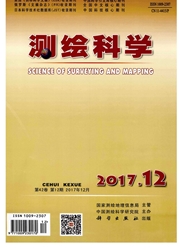

 中文摘要:
中文摘要:
针对跨度较长时间序列共模误差噪声特征研究较少,选择空间滤波的方法对较长时间序列进行分析以满足参考框架建立的需要。选取欧洲地区58个IGS基准站2001—2011年的坐标时间序列,采用区域叠加滤波法、分区区域叠加滤波法和相关系数加权叠加滤波法求取共模误差,并以滤波后时间序列相关系数和残差时间序列标准差为标准对其进行对比分析;进而,利用极大似然估计的方法对每个区域共模误差及滤波前后坐标时间序列进行噪声分析。结果表明:分区区域叠加滤波法最适合欧洲地区共模误差的提取;共模误差主要成分是闪烁噪声,也包含白噪声、随机漫步噪声等;当时间序列长度较长时,N、E方向受共模误差影响较小,可忽略,U方向受共模误差影响较大,需要考虑。
 英文摘要:
英文摘要:
Considering that currently the researches on the common mode error noise characteristics of longer span time series are few,this paper choose to use spatial filtering methods to analyze the longer span time series so as to establish reference framework.Focusing on the coordinate time series of 58 reference stations in Europe,and adopting the regional stacking spatial filtering method,the sectionalized stacking spatial filtering method and the coefficient weighted stacking spatial filtering method to analyze the common-mode error(CME)respectively,this research takes the coefficients of the coordinate time series after filtering and the residuals of time series as standards to make a comparatively analysis of these three spatial filtering methods.On base of this,the research estimates the common-mode error of each area and the time series before and after filtering by means of MLE(maximum likelihood estimation).The result shows that the sectionalized stacking spatial filtering method is the best for gaining the common-mode error in European areas;the common-mode error is mainly caused by flicker noise,while the white noise,random walk noise as well as other noises also make some contributions;and in the cases with relatively longer time series,the effects of common-mode errors in the N and E directions is small and can be ignored,however,the U direction is affected a lot,thus calling for consideration.
 同期刊论文项目
同期刊论文项目
 同项目期刊论文
同项目期刊论文
 期刊信息
期刊信息
